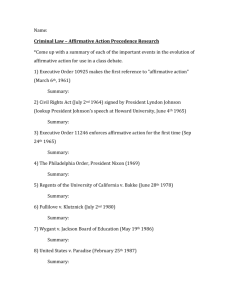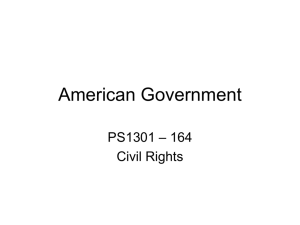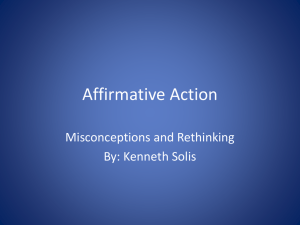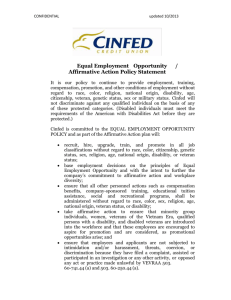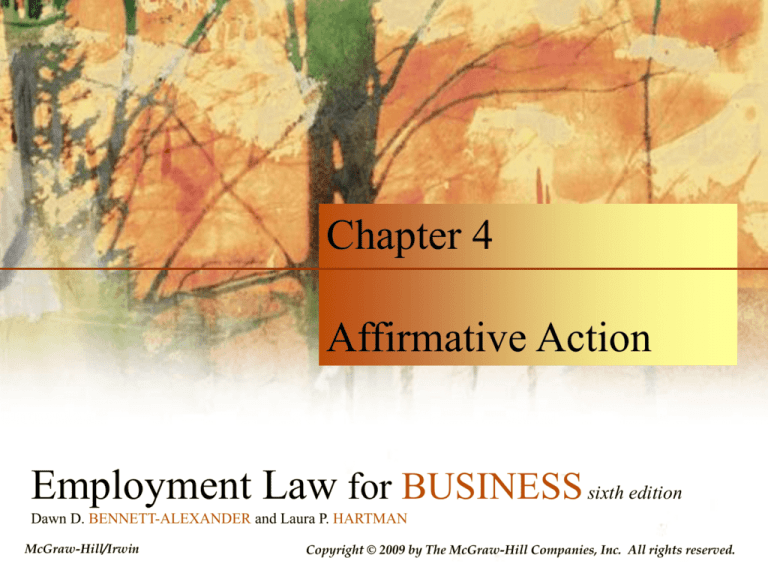
Chapter 4
Affirmative Action
Employment Law for BUSINESS sixth edition
Dawn D. BENNETT-ALEXANDER and Laura P. HARTMAN
McGraw-Hill/Irwin
Copyright © 2009 by The McGraw-Hill Companies, Inc. All rights reserved.
Statutory Basis
(1) The Contractor will not discriminate against any
employee or applicant for employment because of race,
color, religion, sex, or national origin. The contractor
will take affirmative action to ensure that applicants are
employed, and that employees are treated during
employment, without regard to their race, color,
religion, sex, or national origin. Such action shall
include, but not be limited to, the following:
employment, upgrading, demotion, or transfer;
recruitment or recruitment advertising; layoff or
termination; rates of pay or other forms of
compensation; and selection for training, including
apprenticeship. [202, Executive Order 11246.]
4–2
The Design and Unstable History
• 1619─First slaves arrive in America
• 1865─The Civil War ends
• 1865─The 13th Amendment to the Constitution
abolishes slavery
• 1964 ─Civil Rights Act of 1964 is passed
• 1965─Voting Rights Act of 1965 is passed
• 1971─First Important Title VII case decided by
the U.S. Supreme Court
• 1979─First workplace affirmative action case
decided by the U.S. Supreme Court
• 1980s─Affirmative action is hotly debated
• 2004 – The last Civil Ware widow dies
4–3
Affirmative Action Myths
• Affirmative action requires employers to remove
qualified whites and males from their jobs and give
these jobs to minorities and women whether they are
qualified or not.
• Affirmative action prevents employers from hiring
white males who are more qualified for the job.
• Under affirmative action, all an employee must be is a
female or a minority to be placed in a job.
• Most employees who obtain jobs under affirmative
action plans are unqualified for the job.
• Workplace productivity and efficiency always suffer
under affirmative action plans.
• There should be no affirmative action because the best
person is always the one who gets the job.
4–4
The Design and Unstable History
(continued)
L01
• Affirmative action regulations do not
apply to everyone, but only to just over
20 percent of the workforce.
• Affirmative action does not require
quotas.
• Affirmative action involves the employer
bringing qualified women and minorities
(or other statutorily mandated groups)
into a workplace from which it has been
determined that they are excluded.
4–5
The Design and Unstable History
(continued)
• Actions an employer can take include expanded
outreach and recruitment, mentoring,
management training, and hiring.
• Negative attitudes about affirmative action
ran/run exceedingly deep.
• Affirmative action is used only when there is a
demonstrated underrepresentation or a finding
of discrimination.
• Minorities and women still lag behind in pay,
jobs, and promotions.
• “Sins of the father” argument
4–6
The Design and Unstable History
(continued)
L02
• Growth of the middle class—FLSA and the GI
Bill.
• The first workplace affirmative action case did
not reach the U.S. Supreme Court until 1979.
• A workplace should reflect the available
workforce from which its employees are drawn.
• Three ways affirmative actions arise:
– Through Executive order 11246
– Judicially as a remedy for a finding of
discrimination under Title VII
– Voluntary affirmative action
4–7
Affirmative Action Under
Executive Order 11246
• Affirmative action actually stems from a
requirement imposed by Executive Order
11246 and its amendments.
• Executive Order 8802
– Forerunner to E.O. 11246
– Signed on June 25, 1941
– Applied only to defense contracts
• Present version signed into law
September 24, 1965
4–8
E.O. 11246 Provisions
L03
• Prohibits discrimination in employment
• Requires contractors to remedy
inadequate representation of women and
minorities in their workplace
• Enforced by the Office of Federal
Contract Compliance Programs (OFCCP)
– Only applies to federal government contracts
• Increases compliance requirements based
on the amount of the contract.
4–9
Affirmative Action Plans
L04
• Must be developed according to the rules
set forth in the Code of Federal
Regulations
Part 60-2
• Underrepresentation
• Underutilization
• Organizational profile
• Job group analysis
4 – 10
Affirmative Action Plans
(continued)
• Availability
– Based on the availability of women and minorities
qualified for the particular job
• Factors used to determine availability:
– The percentage of minorities or women with
requisite skills in the reasonable recruitment area
– The percentage of minorities or women among those
promotable, transferable, and trainable within the
contractor’s organization
• Placement goal
• Corporate management compliance evaluations
4 – 11
Affirmative Actions
• Advertising for applicants in
nontraditional sources.
• One-for-one hiring, training, or
promotion programs.
• Preferential layoff provisions.
• Extra consideration.
• Lower standards.
• Added points.
• Minority or female “positions.”
4 – 12
Penalties for Noncompliance
• The Secretary of Labor or the appropriate
contracting agency can impose a number
of penalties on the employer.
• The Secretary of Labor must make
reasonable efforts to secure compliance
by conference, conciliation, mediation,
and persuasion before requesting the U.S.
Attorney General to act or before
canceling or surrendering a contract.
4 – 13
Penalties for Noncompliance
(continued)
• What is important to OFCCP:
– The nature and extent of the contractor’s
good faith affirmative action activities.
– The appropriateness of those activities to
the problems the contractor has identified in
the workplace.
4 – 14
Judicial Affirmative Action
• There are no specific requirements as to what
form an affirmative action plan must take
• Regents of the University of California v. Bakke
• Local 28, Sheet Metal Workers v. E.E.O.C.
– Case is over 20 years old
Judicial affirmative action
Affirmative action ordered by a court, rather than arising from
Executive Order 11246.
4 – 15
Voluntary Affirmative Action
• The employer decides to institute an
affirmative action plan regardless of the
Executive Order, and despite no Title VII
cases being brought
• Proactive measure to avoid discrimination
claims
• Strict guidelines must be followed
4 – 16
Reverse Discrimination
L05
L06
L07
• Often considered the flip side of
affirmative action
• Reverse discrimination accounts for only
about 3 percent of the charges filed with
EEOC
• According to the Glass Ceiling
Commission Report, white men are only
43 percent of the Fortune 2000 workforce
but hold 95 percent of the senior
management jobs
4 – 17
Affirmative Action and Veterans
• Jobs for Veterans Act of 2002.
• Contractors must take affirmative action
to hire and promote qualified veterans.
• Under the law, generally, “qualified
targeted veterans are entitled to priority
for referral to federal contractor job
openings.”
4 – 18
Valuing
Diversity/Multiculturalism
L08
• Valuing diversity is learning to accept and
appreciate those who are different from the
majority and value their contributions to the
workplace.
• Multiculturalism is learning to understand,
appreciate, and value (not just “tolerate”) the
unique aspects of cultures different from one’s
own.
• Multiculturalism and valuing diversity
contribute to maximizing production and
minimizing liability.
4 – 19
Management Tips
• Ensure that the hiring, promotion, training, and
other such processes are open, fair, and
available to all employees on an equal basis.
• If an affirmative action plan is to be adopted
voluntarily, work with the union (if there is
one) and other employee groups to try to ensure
fairness and get early approval from the
constituencies affected to ward off potential
litigation.
• Make sure voluntary affirmative action plans
meet established judicial requirements.
4 – 20
Management Tips (continued)
• Provide training about the plan so that all
employees understand its purpose and
intent.
• Implement periodic diversity and related
training.
4 – 21
Summary
• Affirmative action is intentional inclusion of women,
minorities, and others traditionally excluded in the
workplace after demonstrated underrepresentation of
these historically disadvantaged groups.
• Affirmative action plans may arise voluntarily, as a
remedy in a discrimination lawsuit, or as part of an
employer’s responsibilities as a contractor or
subcontractor with the government.
• Employers should conduct voluntary periodic equal
employment opportunity audits to monitor their
workforce for gender, minority, and other inclusion.
4 – 22
McGraw-Hill/Irwin
Summary (continued)
• Such plans should not displace nonminority
employees or permit people to hold positions
for which they are not qualified, simply to meet
affirmative action goals.
• A well-reasoned, flexible plan with
endorsement at the highest levels of the
workplace, applied consistently and diligently,
will greatly aid in diminishing negativity
surrounding affirmative action and in protecting
the employer from adverse legal action.
4 – 23


